Paper Menu >>
Journal Menu >>
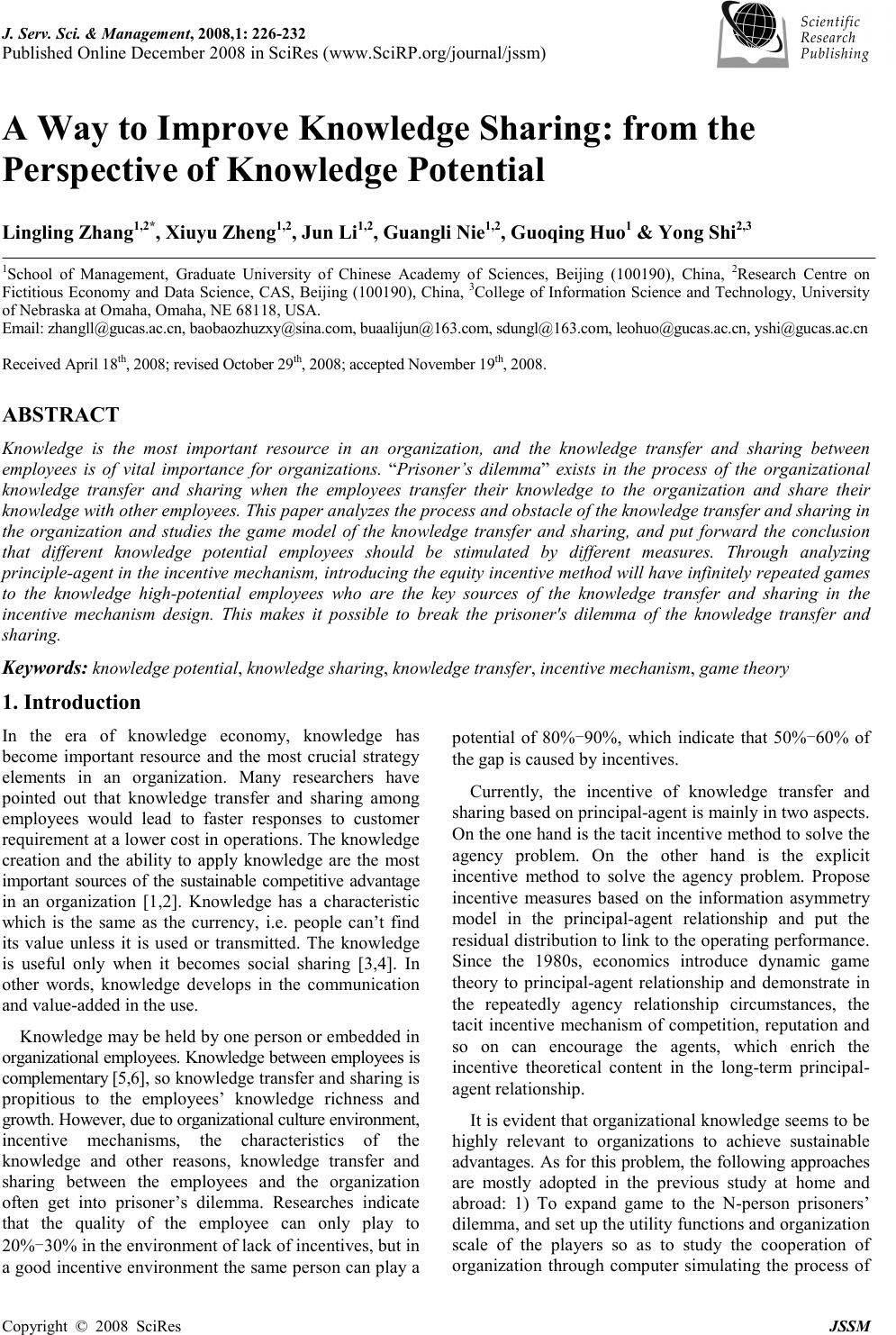 J. Serv. Sci. & Management, 2008,1: 226-232 Published Online December 2008 in SciRes (www.SciRP.org/journal/jssm) Copyright © 2008 SciRes JSSM 1 A Way to Improve Knowledge Sharing: from the Perspective of Knowledge Potential Lingling Zhang 1,2* , Xiuyu Zheng 1,2 , Jun Li 1,2 , Guangli Nie 1,2 , Guoqing Huo 1 & Yong Shi 2,3 1 School of Management, Graduate University of Chinese Academy of Sciences, Beijing (100190), China, 2 Research Centre on Fictitious Economy and Data Science, CAS, Beijing (100190), China, 3 College of Information Science and Technology, University of Nebraska at Omaha, Omaha, NE 68118, USA. Email: zhangll@gucas.ac.cn, baobaozhuzxy@sina.com, buaalijun@163.com, sdungl@163.com, leohuo@gucas.ac.cn, yshi@gucas.ac.cn Received April 18 th , 2008; revised October 29 th , 2008; accepted November 19 th , 2008. ABSTRACT Knowledge is the most important resource in an organization, and the knowledge transfer and sharing between employees is of vital importance for organizations. “Prisoner’s dilemma” exists in the process of the organizational knowledge transfer and sharing when the employees transfer their knowledge to the organization and share their knowledge with other employees. This paper analyzes the process and obstacle of the knowledge transfer and sharing in the organization and studies the game model of the knowledge transfer and sharing, and put forward the conclusion that different knowledge potential employees should be stimulated by different measures. Through analyzing principle-agent in the incentive mechanism, introducing the equity incentive method will have infinitely repeated games to the knowledge high-potential employees who are the key sources of the knowledge transfer and sharing in the incentive mechanism design. This makes it possible to break the prisoner's dilemma of the knowledge transfer and sharing. Keywords: knowledge potential, knowledge sharing, knowledge transfer, incentive mechanism, game theory 1. Introduction In the era of knowledge economy, knowledge has become important resource and the most crucial strategy elements in an organization. Many researchers have pointed out that knowledge transfer and sharing among employees would lead to faster responses to customer requirement at a lower cost in operations. The knowledge creation and the ability to apply knowledge are the most important sources of the sustainable competitive advantage in an organization [1,2]. Knowledge has a characteristic which is the same as the currency, i.e. people can’t find its value unless it is used or transmitted. The knowledge is useful only when it becomes social sharing [3,4]. In other words, knowledge develops in the communication and value-added in the use. Knowledge may be held by one person or embedded in organizational employees. Knowledge between employees is complementary [5,6], so knowledge transfer and sharing is propitious to the employees’ knowledge richness and growth. However, due to organizational culture environment, incentive mechanisms, the characteristics of the knowledge and other reasons, knowledge transfer and sharing between the employees and the organization often get into prisoner’s dilemma. Researches indicate that the quality of the employee can only play to 20%-30% in the environment of lack of incentives, but in a good incentive environment the same person can play a potential of 80%-90%, which indicate that 50%-60% of the gap is caused by incentives. Currently, the incentive of knowledge transfer and sharing based on principal-agent is mainly in two aspects. On the one hand is the tacit incentive method to solve the agency problem. On the other hand is the explicit incentive method to solve the agency problem. Propose incentive measures based on the information asymmetry model in the principal-agent relationship and put the residual distribution to link to the operating performance. Since the 1980s, economics introduce dynamic game theory to principal-agent relationship and demonstrate in the repeatedly agency relationship circumstances, the tacit incentive mechanism of competition, reputation and so on can encourage the agents, which enrich the incentive theoretical content in the long-term principal- agent relationship. It is evident that organizational knowledge seems to be highly relevant to organizations to achieve sustainable advantages. As for this problem, the following approaches are mostly adopted in the previous study at home and abroad: 1) To expand game to the N-person prisoners’ dilemma, and set up the utility functions and organization scale of the players so as to study the cooperation of organization through computer simulating the process of  A Way to Improve Knowledge Sharing: from the Perspective of Knowledge Potential 227 Copyright © 2008 SciRes JSSM the game [7] To introduce the model of infinitely repeated game and to institute the rules of knowledge transfer and sharing based on the experimental results of AXELROD so as to find out solutions [8,9,10]. The limitations of the previous studies are as follows: 1) The study is mainly focused on the analysis of the game model, and specific and feasible solutions suitable for corporations haven’t been given. 2) Research is generally confined to break “prisoner dilemma” between the employees and the organization or between the employees, not having a good combination of them to analysis. 3) The utility function of the players is a specific function supposed by the writer, which cannot reflect the effect of knowledge sharing on the players fully and exactly. In this paper we focus on the different knowledge potential of the employees in the organization, combining knowledge transfer and sharing between the employees and the organization to analysis, and design incentive mechanisms for the different employees which enable the employees and organization to achieve a win-win situation. The results demonstrate research on improving efficiency of organizational knowledge transfer and sharing based on knowledge potential is effective. The rest part of this paper is organized as follows. The analysis of obstacles of knowledge transfer and sharing in the organization is presented in the next section. In Section 3, the game model of the knowledge transfer and sharing is described. Research on incentive mechanisms in knowledge transfer and sharing is discussed in Section 4. Section 5 concludes the paper with a discussion of the implications and limitations of this study, research directions, and concluding remarks. 2. The Analysis of Obstacles of Knowledge Transfer and Sharing in the Organization A large number of scholars emphasize the importance of knowledge transfer and sharing in many related areas. According to the view of some scholars, the ability to transfer knowledge is a system which is superior to other arrangements such as unique source of market organizational competitive advantage [2]. An effective knowledge transfer and sharing is considered to be the key to a series organizational process and results, including best practice transfer, new product development, learning speed and organizational survival. So how to promote the employees in the organization to transfer and share knowledge is an important research topic. Knowledge transfer and sharing cannot progress naturally in an organization. In addition to the organizational structure, enterprise culture and the application of information technology etc external factors, the most important part is still its internal factors. The knowledge has the characteristics of public property [11,12], the high cost production, the use of non-exclusive, but low dissemination cost. Once the knowledge is transferred or shared, its exclusive rights will be lost, while the exclusive rights are always the embodiment of the employees’ values in the enterprises as well as guarantee of the security of their occupations. In the process of knowledge transfer and sharing, the employees obtain profits while they pay cost, therefore, employees’ utility can be regarded as the difference between the gained profits and the costs. The employees are concerned that sharing knowledge has negative effects which will reduce their original knowledge value and undermine the competitiveness in the organization. Thus, when the employee cannot access to others’ exclusive knowledge or hasn’t got any compensation, his proceeds will be negative. The employee will lose his special value in the organization because of losing the exclusivity of knowledge. Because the employees’ core knowledge is always tacit, the knowledge sharing must be based on a voluntary basis. So there are few people who are willing to share their core knowledge with others, which create the knowledge sharing barriers. 3. The Game Model of the Knowledge Transfer and Sharing 3.1. Knowledge Transfer between the Employees and the Organization In the organization there are two forms in the knowledge transfer and sharing, one is between the employee and the organization, the other is between the employees. If all the employees are willing to transfer and share their own knowledge, not only the employees will raise their knowledge and skills, but also it’s useful for the organization. The decisive factors to the quality and effectiveness of knowledge transfer and sharing are the subjective desire of the knowledge owner. As the organizations are unable to observe and measure the employees’ knowledge sharing, so there are games exist between the employees and the organization. Assuming. k : Knowledge volume of the employees transfer and sharing. W : The incentive costs which organizations pay to the employees under encouragement. ( ) C k : The costs of employees’ knowledge transfer. It refers to the fact that the knowledge receivers pay out the amount of time, energy and opportunity cost during the knowledge transfer, and knowledge owners pay out time, energy and the loss of competitive advantages due to knowledge transfer and sharing. ( ) k π : The output of knowledge transfer and sharing to the organization. As the employees’ knowledge transfer and sharing is highly difficult to detect in the organizations, so the 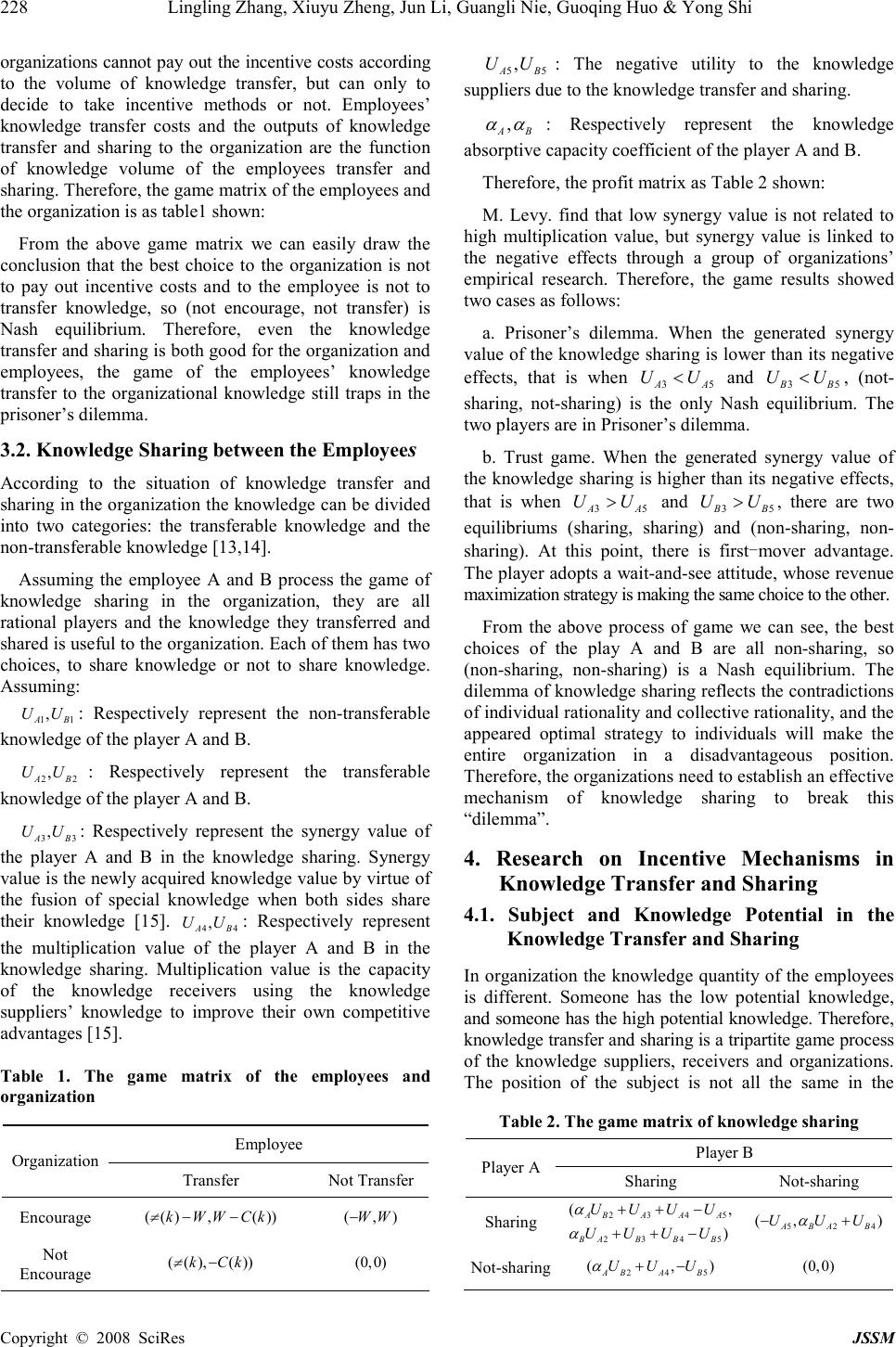 228 Lingling Zhang, Xiuyu Zheng, Jun Li, Guangli Nie, Guoqing Huo & Yong Shi Copyright © 2008 SciRes JSSM organizations cannot pay out the incentive costs according to the volume of knowledge transfer, but can only to decide to take incentive methods or not. Employees’ knowledge transfer costs and the outputs of knowledge transfer and sharing to the organization are the function of knowledge volume of the employees transfer and sharing. Therefore, the game matrix of the employees and the organization is as table1 shown: From the above game matrix we can easily draw the conclusion that the best choice to the organization is not to pay out incentive costs and to the employee is not to transfer knowledge, so (not encourage, not transfer) is Nash equilibrium. Therefore, even the knowledge transfer and sharing is both good for the organization and employees, the game of the employees’ knowledge transfer to the organizational knowledge still traps in the prisoner’s dilemma. 3.2. Knowledge Sharing between the Employee s According to the situation of knowledge transfer and sharing in the organization the knowledge can be divided into two categories: the transferable knowledge and the non-transferable knowledge [13,14]. Assuming the employee A and B process the game of knowledge sharing in the organization, they are all rational players and the knowledge they transferred and shared is useful to the organization. Each of them has two choices, to share knowledge or not to share knowledge. Assuming: 1 1 , A B U U : Respectively represent the non-transferable knowledge of the player A and B. 2 2 , A B U U : Respectively represent the transferable knowledge of the player A and B. 3 3 , A B U U : Respectively represent the synergy value of the player A and B in the knowledge sharing. Synergy value is the newly acquired knowledge value by virtue of the fusion of special knowledge when both sides share their knowledge [15]. 4 4 , A B U U : Respectively represent the multiplication value of the player A and B in the knowledge sharing. Multiplication value is the capacity of the knowledge receivers using the knowledge suppliers’ knowledge to improve their own competitive advantages [15]. Table 1. The game matrix of the employees and organization Employee Organization Transfer Not Transfer Encourage (( ),( )) kW WCk π − − (, ) W W − Not Encourage (( ),( )) kCk π − (0,0) 5 5 , A B U U : The negative utility to the knowledge suppliers due to the knowledge transfer and sharing. , A B α α : Respectively represent the knowledge absorptive capacity coefficient of the player A and B. Therefore, the profit matrix as Table 2 shown: M. Levy. find that low synergy value is not related to high multiplication value, but synergy value is linked to the negative effects through a group of organizations’ empirical research. Therefore, the game results showed two cases as follows: a. Prisoner’s dilemma. When the generated synergy value of the knowledge sharing is lower than its negative effects, that is when 3 5 A A U U < and 3 5 B B U U < , (not- sharing, not-sharing) is the only Nash equilibrium. The two players are in Prisoner’s dilemma. b. Trust game. When the generated synergy value of the knowledge sharing is higher than its negative effects, that is when 3 5 A A U U > and 3 5 B B U U > , there are two equilibriums (sharing, sharing) and (non-sharing, non- sharing). At this point, there is first-mover advantage. The player adopts a wait-and-see attitude, whose revenue maximization strategy is making the same choice to the other. From the above process of game we can see, the best choices of the play A and B are all non-sharing, so (non-sharing, non-sharing) is a Nash equilibrium. The dilemma of knowledge sharing reflects the contradictions of individual rationality and collective rationality, and the appeared optimal strategy to individuals will make the entire organization in a disadvantageous position. Therefore, the organizations need to establish an effective mechanism of knowledge sharing to break this “dilemma”. 4. Research on Incentive Mechanisms in Knowledge Transfer and Sharing 4.1. Subject and Knowledge Potential in the Knowledge Transfer and Sharing In organization the knowledge quantity of the employees is different. Someone has the low potential knowledge, and someone has the high potential knowledge. Therefore, knowledge transfer and sharing is a tripartite game process of the knowledge suppliers, receivers and organizations. The position of the subject is not all the same in the Table 2. The game matrix of knowledge sharing Player B Player A Sharing Not-sharing Sharing 2 345 2 34 5 ( , ) A BAAA BA B BB UUU U UUU U α α + +− + +− 52 4 ( ,) AB AB UU U α − + Not-sharing 2 4 5 (, ) A BAB U U U α + − (0,0) 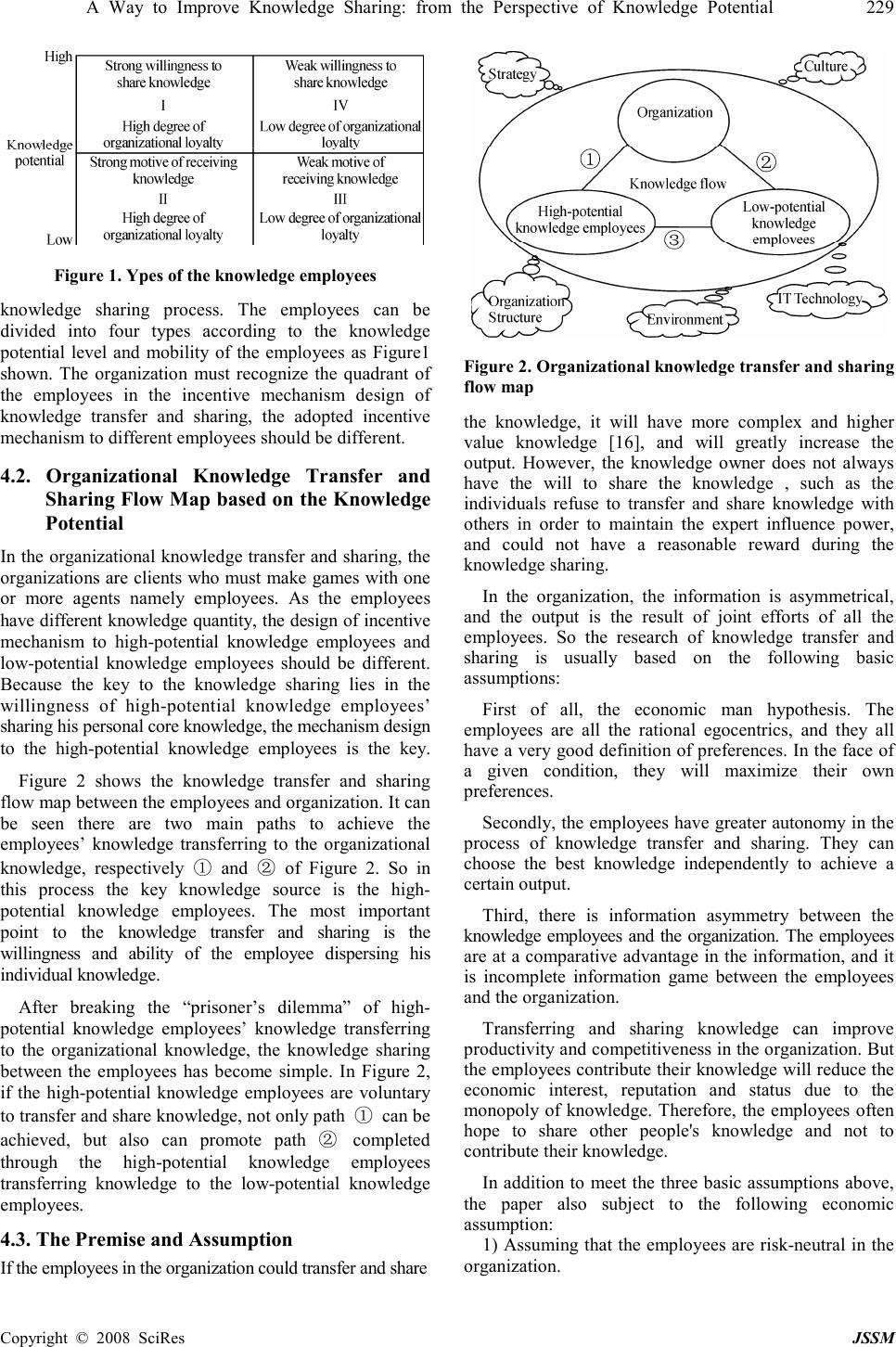 A Way to Improve Knowledge Sharing: from the Perspective of Knowledge Potential 229 Copyright © 2008 SciRes JSSM Figure 1. Ypes of the knowledge employees knowledge sharing process. The employees can be divided into four types according to the knowledge potential level and mobility of the employees as Figure1 shown. The organization must recognize the quadrant of the employees in the incentive mechanism design of knowledge transfer and sharing, the adopted incentive mechanism to different employees should be different. 4.2. Organizational Knowledge Transfer and Sharing Flow Map based on the Knowledge Potential In the organizational knowledge transfer and sharing, the organizations are clients who must make games with one or more agents namely employees. As the employees have different knowledge quantity, the design of incentive mechanism to high-potential knowledge employees and low-potential knowledge employees should be different. Because the key to the knowledge sharing lies in the willingness of high-potential knowledge employees’ sharing his personal core knowledge, the mechanism design to the high-potential knowledge employees is the key. Figure 2 shows the knowledge transfer and sharing flow map between the employees and organization. It can be seen there are two main paths to achieve the employees’ knowledge transferring to the organizational knowledge, respectively ① and ② of Figure 2. So in this process the key knowledge source is the high- potential knowledge employees. The most important point to the knowledge transfer and sharing is the willingness and ability of the employee dispersing his individual knowledge. After breaking the “prisoner’s dilemma” of high- potential knowledge employees’ knowledge transferring to the organizational knowledge, the knowledge sharing between the employees has become simple. In Figure 2, if the high-potential knowledge employees are voluntary to transfer and share knowledge, not only path ① can be achieved, but also can promote path ② completed through the high-potential knowledge employees transferring knowledge to the low-potential knowledge employees. 4.3. The Premise and Assumption If the employees in the organization could transfer and share Figure 2. Organizational knowledge transfer and sharing flow map the knowledge, it will have more complex and higher value knowledge [16], and will greatly increase the output. However, the knowledge owner does not always have the will to share the knowledge , such as the individuals refuse to transfer and share knowledge with others in order to maintain the expert influence power, and could not have a reasonable reward during the knowledge sharing. In the organization, the information is asymmetrical, and the output is the result of joint efforts of all the employees. So the research of knowledge transfer and sharing is usually based on the following basic assumptions: First of all, the economic man hypothesis. The employees are all the rational egocentrics, and they all have a very good definition of preferences. In the face of a given condition, they will maximize their own preferences. Secondly, the employees have greater autonomy in the process of knowledge transfer and sharing. They can choose the best knowledge independently to achieve a certain output. Third, there is information asymmetry between the knowledge employees and the organization. The employees are at a comparative advantage in the information, and it is incomplete information game between the employees and the organization. Transferring and sharing knowledge can improve productivity and competitiveness in the organization. But the employees contribute their knowledge will reduce the economic interest, reputation and status due to the monopoly of knowledge. Therefore, the employees often hope to share other people's knowledge and not to contribute their knowledge. In addition to meet the three basic assumptions above, the paper also subject to the following economic assumption: 1) Assuming that the employees are risk-neutral in the organization. 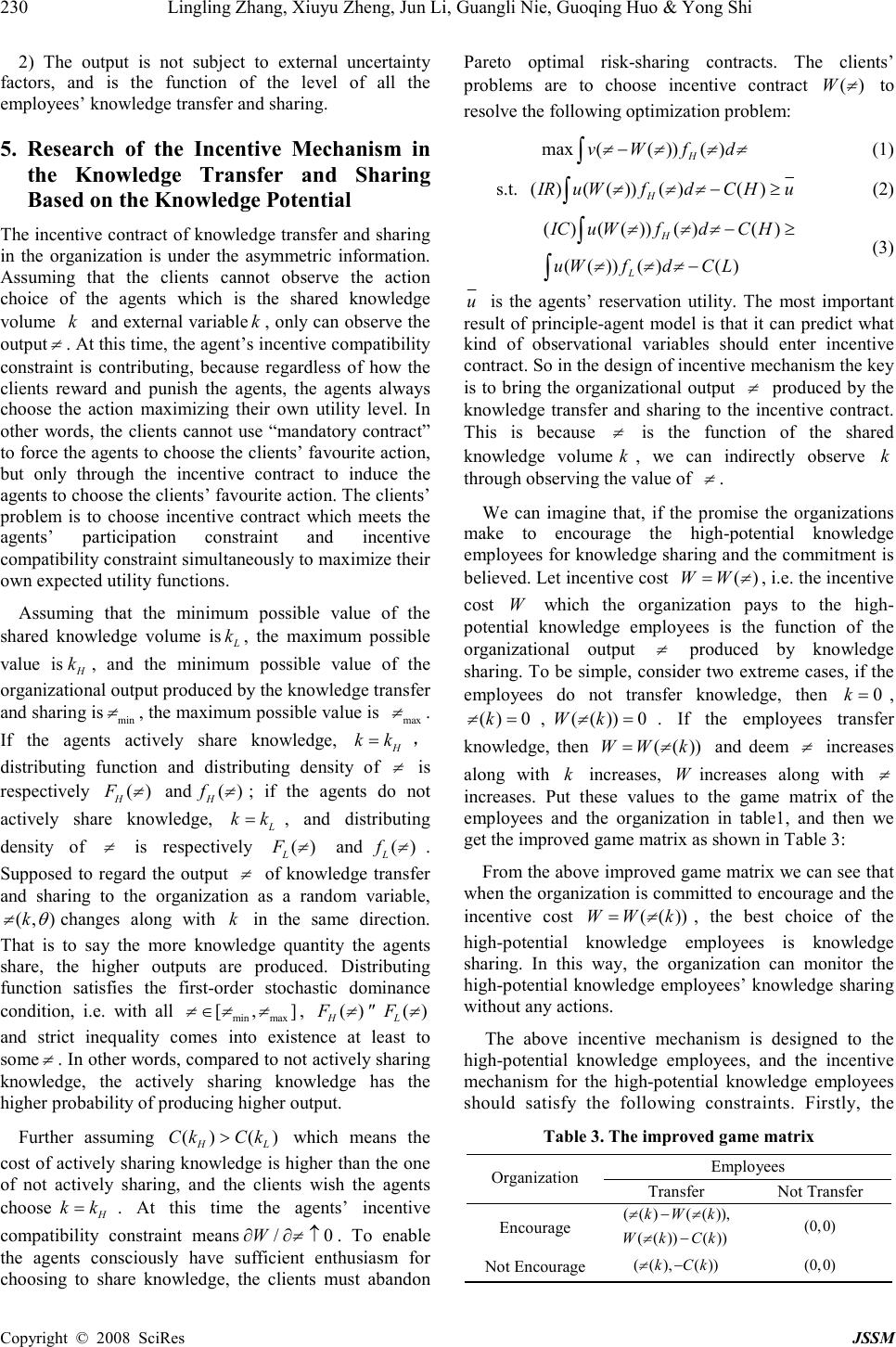 230 Lingling Zhang, Xiuyu Zheng, Jun Li, Guangli Nie, Guoqing Huo & Yong Shi Copyright © 2008 SciRes JSSM 2) The output is not subject to external uncertainty factors, and is the function of the level of all the employees’ knowledge transfer and sharing. 5. Research of the Incentive Mechanism in the Knowledge Transfer and Sharing Based on the Knowledge Potential The incentive contract of knowledge transfer and sharing in the organization is under the asymmetric information. Assuming that the clients cannot observe the action choice of the agents which is the shared knowledge volume k and external variable k , only can observe the output π . At this time, the agent’s incentive compatibility constraint is contributing, because regardless of how the clients reward and punish the agents, the agents always choose the action maximizing their own utility level. In other words, the clients cannot use “mandatory contract” to force the agents to choose the clients’ favourite action, but only through the incentive contract to induce the agents to choose the clients’ favourite action. The clients’ problem is to choose incentive contract which meets the agents’ participation constraint and incentive compatibility constraint simultaneously to maximize their own expected utility functions. Assuming that the minimum possible value of the shared knowledge volume is L k , the maximum possible value is H k , and the minimum possible value of the organizational output produced by the knowledge transfer and sharing is min π , the maximum possible value is max π . If the agents actively share knowledge, H k k = , distributing function and distributing density of π is respectively ( ) H F π and ( ) H f π ; if the agents do not actively share knowledge, L k k = , and distributing density of π is respectively ( ) L F π and ( ) L f π . Supposed to regard the output π of knowledge transfer and sharing to the organization as a random variable, ( ,) k π θ changes along with k in the same direction. That is to say the more knowledge quantity the agents share, the higher outputs are produced. Distributing function satisfies the first-order stochastic dominance condition, i.e. with all min max [ ,] π ππ ∈ , ( )( ) H L F F π π ≤ and strict inequality comes into existence at least to some π . In other words, compared to not actively sharing knowledge, the actively sharing knowledge has the higher probability of producing higher output. Further assuming ()( ) H L C kCk > which means the cost of actively sharing knowledge is higher than the one of not actively sharing, and the clients wish the agents choose H k k = . At this time the agents’ incentive compatibility constraint means / 0 W π ∂∂ ≠ . To enable the agents consciously have sufficient enthusiasm for choosing to share knowledge, the clients must abandon Pareto optimal risk-sharing contracts. The clients’ problems are to choose incentive contract ( ) W π to resolve the following optimization problem: max(( ))( ) H v Wfd πππ π − ∫ (1) s.t. ()(())( )() H IRu WfdCHu ππ π − ≥ ∫ (2) ()(( ))( )() (( ))()() H L ICu WfdCH u WfdCL πππ ππ π − ≥ − ∫ ∫ (3) u is the agents’ reservation utility. The most important result of principle-agent model is that it can predict what kind of observational variables should enter incentive contract. So in the design of incentive mechanism the key is to bring the organizational output π produced by the knowledge transfer and sharing to the incentive contract. This is because π is the function of the shared knowledge volume k , we can indirectly observe k through observing the value of π . We can imagine that, if the promise the organizations make to encourage the high-potential knowledge employees for knowledge sharing and the commitment is believed. Let incentive cost ( ) W W π = , i.e. the incentive cost W which the organization pays to the high- potential knowledge employees is the function of the organizational output π produced by knowledge sharing. To be simple, consider two extreme cases, if the employees do not transfer knowledge, then 0 k = , ( )0 k π = , (( ))0 W k π = . If the employees transfer knowledge, then (( )) W Wk π = and deem π increases along with k increases, W increases along with π increases. Put these values to the game matrix of the employees and the organization in table1, and then we get the improved game matrix as shown in Table 3: From the above improved game matrix we can see that when the organization is committed to encourage and the incentive cost (( )) W Wk π = , the best choice of the high-potential knowledge employees is knowledge sharing. In this way, the organization can monitor the high-potential knowledge employees’ knowledge sharing without any actions. The above incentive mechanism is designed to the high-potential knowledge employees, and the incentive mechanism for the high-potential knowledge employees should satisfy the following constraints. Firstly, the Table 3. The improved game matrix Employees Organization Transfer Not Transfer Encourage (( )(( )), (( ))()) k Wk WkCk π π π − − (0,0) Not Encourage (( ),( )) kCk π − (0,0) 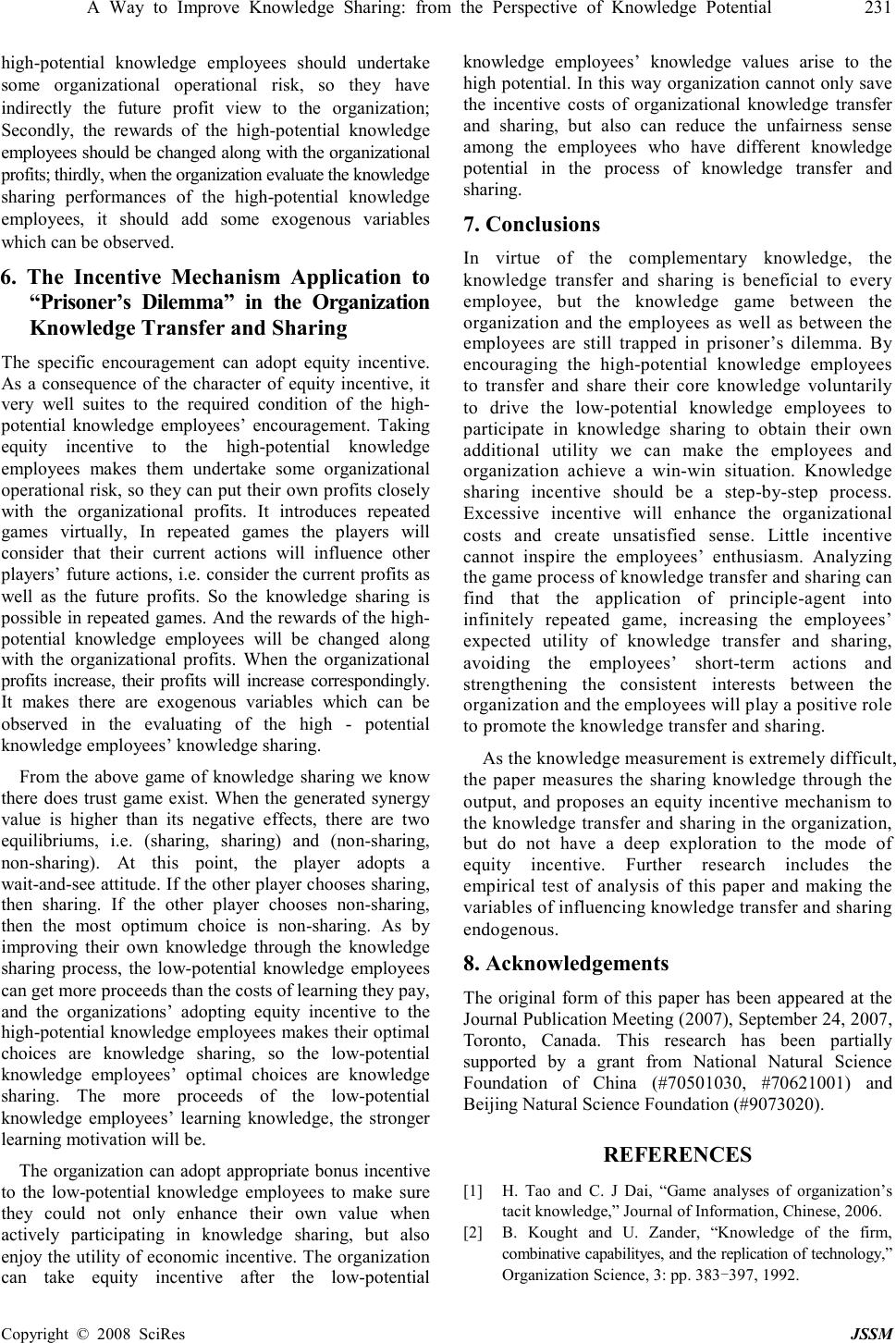 A Way to Improve Knowledge Sharing: from the Perspective of Knowledge Potential 231 Copyright © 2008 SciRes JSSM high-potential knowledge employees should undertake some organizational operational risk, so they have indirectly the future profit view to the organization; Secondly, the rewards of the high-potential knowledge employees should be changed along with the organizational profits; thirdly, when the organization evaluate the knowledge sharing performances of the high-potential knowledge employees, it should add some exogenous variables which can be observed. 6. The Incentive Mechanism Application to “Prisoner’s Dilemma” in the Organization Knowledge Transfer and Sharing The specific encouragement can adopt equity incentive. As a consequence of the character of equity incentive, it very well suites to the required condition of the high- potential knowledge employees’ encouragement. Taking equity incentive to the high-potential knowledge employees makes them undertake some organizational operational risk, so they can put their own profits closely with the organizational profits. It introduces repeated games virtually, In repeated games the players will consider that their current actions will influence other players’ future actions, i.e. consider the current profits as well as the future profits. So the knowledge sharing is possible in repeated games. And the rewards of the high- potential knowledge employees will be changed along with the organizational profits. When the organizational profits increase, their profits will increase correspondingly. It makes there are exogenous variables which can be observed in the evaluating of the high - potential knowledge employees’ knowledge sharing. From the above game of knowledge sharing we know there does trust game exist. When the generated synergy value is higher than its negative effects, there are two equilibriums, i.e. (sharing, sharing) and (non-sharing, non-sharing). At this point, the player adopts a wait-and-see attitude. If the other player chooses sharing, then sharing. If the other player chooses non-sharing, then the most optimum choice is non-sharing. As by improving their own knowledge through the knowledge sharing process, the low-potential knowledge employees can get more proceeds than the costs of learning they pay, and the organizations’ adopting equity incentive to the high-potential knowledge employees makes their optimal choices are knowledge sharing, so the low-potential knowledge employees’ optimal choices are knowledge sharing. The more proceeds of the low-potential knowledge employees’ learning knowledge, the stronger learning motivation will be. The organization can adopt appropriate bonus incentive to the low-potential knowledge employees to make sure they could not only enhance their own value when actively participating in knowledge sharing, but also enjoy the utility of economic incentive. The organization can take equity incentive after the low-potential knowledge employees’ knowledge values arise to the high potential. In this way organization cannot only save the incentive costs of organizational knowledge transfer and sharing, but also can reduce the unfairness sense among the employees who have different knowledge potential in the process of knowledge transfer and sharing. 7. Conclusions In virtue of the complementary knowledge, the knowledge transfer and sharing is beneficial to every employee, but the knowledge game between the organization and the employees as well as between the employees are still trapped in prisoner’s dilemma. By encouraging the high-potential knowledge employees to transfer and share their core knowledge voluntarily to drive the low-potential knowledge employees to participate in knowledge sharing to obtain their own additional utility we can make the employees and organization achieve a win-win situation. Knowledge sharing incentive should be a step-by-step process. Excessive incentive will enhance the organizational costs and create unsatisfied sense. Little incentive cannot inspire the employees’ enthusiasm. Analyzing the game process of knowledge transfer and sharing can find that the application of principle-agent into infinitely repeated game, increasing the employees’ expected utility of knowledge transfer and sharing, avoiding the employees’ short-term actions and strengthening the consistent interests between the organization and the employees will play a positive role to promote the knowledge transfer and sharing. As the knowledge measurement is extremely difficult, the paper measures the sharing knowledge through the output, and proposes an equity incentive mechanism to the knowledge transfer and sharing in the organization, but do not have a deep exploration to the mode of equity incentive. Further research includes the empirical test of analysis of this paper and making the variables of influencing knowledge transfer and sharing endogenous. 8. Acknowledgements The original form of this paper has been appeared at the Journal Publication Meeting (2007), September 24, 2007, Toronto, Canada. This research has been partially supported by a grant from National Natural Science Foundation of China (#70501030, #70621001) and Beijing Natural Science Foundation (#9073020). REFERENCES [1] H. Tao and C. J Dai, “Game analyses of organization’s tacit knowledge,” Journal of Information, Chinese, 2006. [2] B. Kought and U. Zander, “Knowledge of the firm, combinative capabilityes, and the replication of technology,” Organization Science, 3: pp. 383 - 397, 1992. 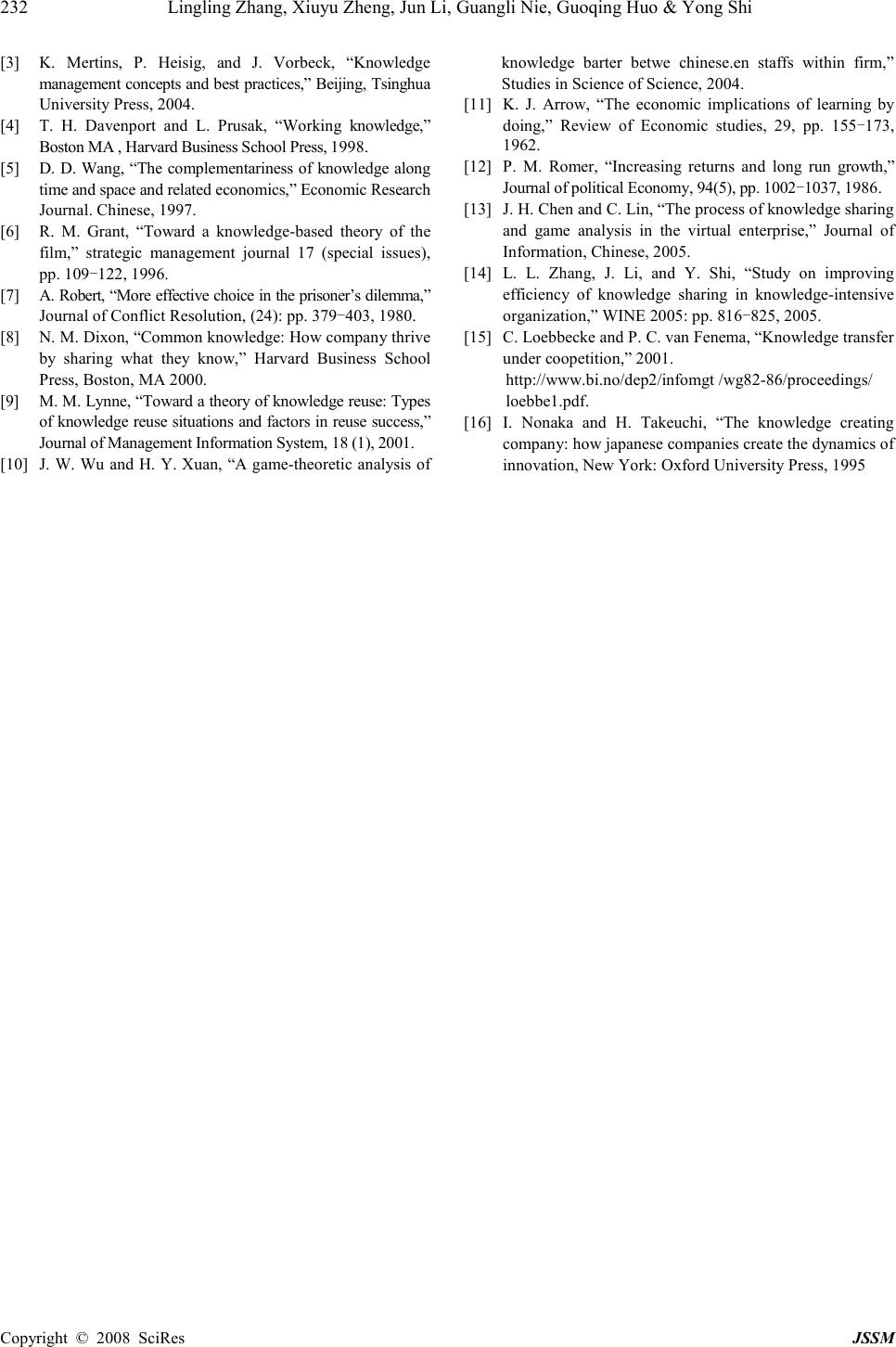 232 Lingling Zhang, Xiuyu Zheng, Jun Li, Guangli Nie, Guoqing Huo & Yong Shi Copyright © 2008 SciRes JSSM [3] K. Mertins, P. Heisig, and J. Vorbeck, “Knowledge management concepts and best practices,” Beijing, Tsinghua University Press, 2004. [4] T. H. Davenport and L. Prusak, “Working knowledge,” Boston MA , Harvard Business School Press, 1998. [5] D. D. Wang, “The complementariness of knowledge along time and space and related economics,” Economic Research Journal. Chinese, 1997. [6] R. M. Grant, “Toward a knowledge-based theory of the film,” strategic management journal 17 (special issues), pp. 109 - 122, 1996. [7] A. Robert, “More effective choice in the prisoner’s dilemma,” Journal of Conflict Resolution, (24): pp. 379 - 403, 1980. [8] N. M. Dixon, “Common knowledge: How company thrive by sharing what they know,” Harvard Business School Press, Boston, MA 2000. [9] M. M. Lynne, “Toward a theory of knowledge reuse: Types of knowledge reuse situations and factors in reuse success,” Journal of Management Information System, 18 (1), 2001. [10] J. W. Wu and H. Y. Xuan, “A game-theoretic analysis of knowledge barter betwe chinese.en staffs within firm,” Studies in Science of Science, 2004. [11] K. J. Arrow, “The economic implications of learning by doing,” Review of Economic studies, 29, pp. 155 - 173, 1962. [12] P. M. Romer, “Increasing returns and long run growth,” Journal of political Economy, 94(5), pp. 1002 - 1037, 1986. [13] J. H. Chen and C. Lin, “The process of knowledge sharing and game analysis in the virtual enterprise,” Journal of Information, Chinese, 2005. [14] L. L. Zhang, J. Li, and Y. Shi, “Study on improving efficiency of knowledge sharing in knowledge-intensive organization,” WINE 2005: pp. 816 - 825, 2005. [15] C. Loebbecke and P. C. van Fenema, “Knowledge transfer under coopetition,” 2001. http://www.bi.no/dep2/infomgt /wg82-86/proceedings/ loebbe1.pdf. [16] I. Nonaka and H. Takeuchi, “The knowledge creating company: how japanese companies create the dynamics of innovation, New York: Oxford University Press, 1995 |

